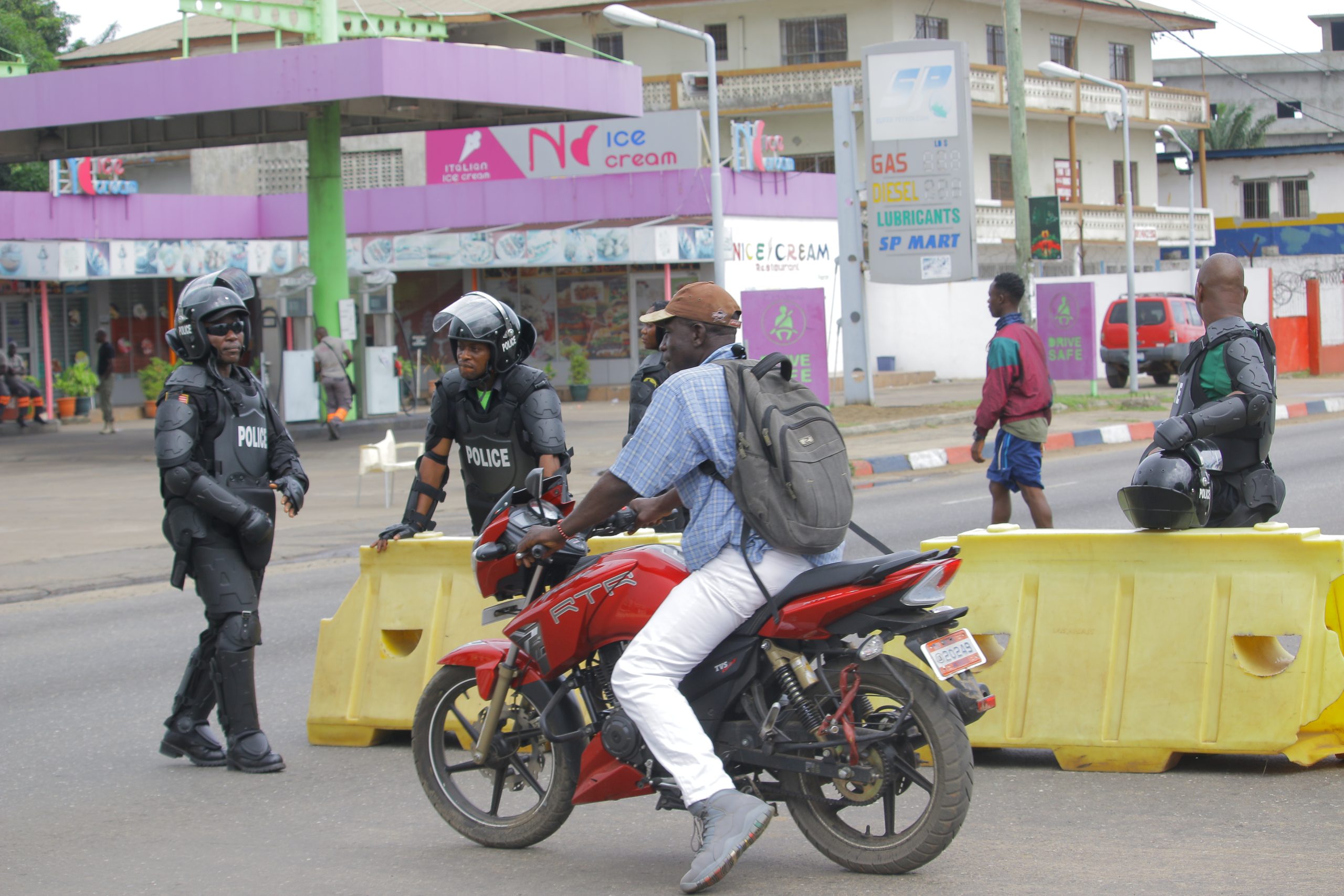Top: A man on a motorcycle and the police in Sinkor. The DayLight/Harry Browne
By Elchico M. Fawundu
I took a detour from Oldroad (Kailondo Junction) and hit Tubman Boulevard in full view heading to Congo town. While the road stretched out its receiving arms, I received a phone call from a pal. I took the phone and held it on a loudspeaker so that I could at the same, embrace the road. Almost immediately that affection seemed uncomfortable as I witnessed two motorcycles collision which instantaneously left one rider motionless at Catholic Junction.
I hastened to cut off my phone as this was almost like a motion picture in foreplay. The disoriented motorcyclist struggled to collect his counterpart who had passed out as though he was in an enchanted sleep and the passengers tried to recollect their possessions or at least what they could find. Then and there, I realized the magnitude of motorcycle accidents.
In all fairness, I must admit I have witnessed my fair share of motorcyclists always tumbling in front of my vehicle and the riders politely gathering themselves up but this was the first of its kind.
Seemingly, The Liberia National Police (LNP) in its new regulation to uphold public safety with emphasis on Road safety has caused quite a stir for bike riders, especially the regulation that deals with riders wearing protective gear (reflectors, helmets, driver’s licenses and insurance).
Basically, the ruckus has largely been due to poor or little public assumptions on the unceremonious request rather than the conventional usage of those gears.
The public mixed reactions are attributed to a lack of education and the unaccustomed use of those gears. However, some tangential and hygienic concerns have been raised.
Statistically, research conducted by Front Page Africa in its article: Liberia: 139 Die in Road accidents from January to September 2022, states that motorcycle-to-motorcycle deaths stand at 169, motorcycle car is 399, motorcycle-to-pedestrian is 116 and tricycle to motorcycle is 39, respectively.
It can also be emphasized that the supra stats notably recognize just three-quarters of a particular year and at the same time, leave out all fatal and minor associated injuries.
The need to address this public safety hazard cannot be overemphasized.
Interestingly, the new regulation has triggered the tease in most quarters, too much to some bemusement and too little to some annoyance. This may have stemmed from the unhabitual practice and its adverse effects.
Besides, the fact that Monrovia, if not Liberia has few traffic indicators which help in mitigating road hazards and helping in regulating traffic flow, many find the regulation meaningless.
Many equally find the regulation handy and timely as the impact of motorcycle accidents has large and lasting effects on its victims (both the driver and rider).
The center of commotion has up to this point been the hygienic and limited transportation aspects.
Transportation in our country has been a challenge in comparison. There is no statistical evidence available to point out the amount of vehicle to a person(s) and the last unofficial report from NTA placed public transportation at 2 poorly refurbished buses taken over from the past government. (OK FM, Morning Rush)
Thus, leading to a hike in Commercial motorcycles; there isn’t any at hand stat on the amount of motorcycles in circulation but it has proven convenient for students and commuters, especially in the early hours of the day and late hours of the night.
Conversely, riding motorcycles is more dangerous in general than other vehicles and this is because they don’t have safety features like airbags, or seatbelts, and riders are more vulnerable to a collision.
Many riders are keen on the final destination especially if the vehicle is unconventional order rather than the process of arriving safely. Comments on social media and radio reactions since the introduction have skyrocketed against the practice.
Hygienically, the risks of sharing a helmet can be identified as traction to the hair if it isn’t properly worn, exacerbates bacteria accumulation on the scalp surface and causes scalp infection if the inner lining (helmet) is unhygienic some of which are long-term effects. Furthermore, helmets if not the rightful size and/or model may result in discomfort, heat, restriction of vision hearing and hair damage; However, Helmets reduce the risk of serious brain injuries and death in the worst case during a fall and/or collision. It also absorbed shocks from impacts up to 250 pounds.
Realistically, there is far more work to be done by all parties involved, the Public, the hygiene and limited public transport while the LNP is concerned about public safety which in its essence is the overall protection of all parties (Motorcyclists and Riders) and some extent pedestrians, respectively.
Some mitigations would be to educate motorcyclists and riders on the safety of wearing protective gear and the reintroduction of street indicators with inclusive motorcycle indicators and also encourage the motorcyclists to buy some specific rider helmets (full face, open face and modular helmet) all of which result into different effects on riders( passengers).
This will help save the lives of many riders and at the same time, reach riders to final destinations in one piece.
Elchico M. Fawundu is an environmental science lecturer at Stella Maris Polytechnic University.



